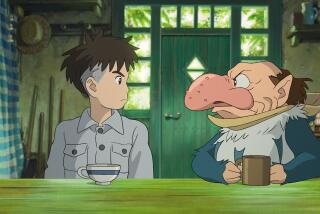Astro Boy as role model
- Share via
The smiling boy with the pointy hairdo flying into theaters today in David Bowers’ computer-generated film “Astro Boy” isn’t just a clever diversion for the kids. He’s got a storied past that helped revolutionize manga and launch the artistic explosion that became anime. He also paved the way for the “Pokemon,” “Naruto” and “Yu-Gi-Oh” cartoons currently on American airwaves.
After a failed outing early in 1951, when graphic novelist and filmmaker Osamu Tezuka first introduced the robot as the peacemaking Ambassador Atom in a Japanese magazine for boys, “Astro Boy” as we know him was launched a year later.
In the new manga story, brilliant scientist Dr. Boynton loses his son Aster in an automobile accident, so he creates Astro Boy as a replacement. Beneath his cute exterior, the little robot has a 100,000-horsepower engine, rocket jets in his legs and machine guns in his derriere. When Boynton realizes his android can never grow up, he sells Astro to a circus. Dr. Packadermus Elefun rescues him and becomes his surrogate father.
The manga, which would soon go on to become an animated TV series in Japan and in the U.S., tackled social issues in an accessible way.
“The original stories are much more sophisticated than the animated series,” says Frederik L. Schodt, author of “The Astro Boy Essays,” who notes that, though begun in the ‘50s, the series was set in 2003. “It’s fascinating to see how Tezuka foresaw some of our problems with artificial intelligence, ecology -- even suicide bombing and terrorism. There are stories that address racial discrimination in the United States and discrimination within Japan. He even had Astro Boy go to Vietnam and protect the villagers from American bombers. It’s hard to believe all that’s built into a story designed for 10-year-old boys.”
--
Low-budget origins
A celebrated hero in Japan, Tezuka, who produced animated features for Toie Studio, introduced cinematic storytelling into manga, drawing close-ups, master shots and sequences of images that suggest camera moves.
An animated adaptation of “Astro Boy” premiered on Japanese television in 1963 and ran for 193 episodes. It was not the first Japanese animated TV series, but it was the first with a continuing story. Its popularity bolstered the fledgling Japanese animation industry: Until then, Japanese stations had broadcast dubbed American shows.
Of Astro Boy’s success, Tezuka’s son, Macoto Tezka (he shortened his last name), said in an e-mail interview, “Astro Boy has super powers, but his appearance is as an adorable child and he has a pure mind. The animated ‘Astro Boy’ started right after I was born. So sometimes I feel like Astro is my twin brother.”
Although Tezuka greatly admired the films of Walt Disney, the “Astro Boy” television program was made on an absurdly small budget that precluded fluid animation. Fans often compare Tezuka, who died in 1989, to Disney, but Bill Hanna and Joe Barbera might be a more apt comparison: “Astro Boy” established animation in Japan as a product that could be turned out quickly and cheaply. Later animators, including Hayao Miyazaki, have criticized Tezuka’s decision to accept such small budgets and tight deadlines, with which they still struggle.
As Schodt notes, the stories in the animated “Astro Boy” were simpler and less sophisticated than the original manga. The stories were then further simplified, and most of the scenes depicting violence or racial minorities were excised in the dubbed version that premiered on WPIX in New York in September 1963 -- the first Japanese animated program to air in the U.S.
In 1980, Tezuka worked on a second, color version of “Astro Boy,” which was better animated than the 1963 original. But action scenes lacked pizazz, and the pedestrian English dub failed to generate much excitement. Still wildly popular in Japan, however, Sony produced a third “Astro Boy” series in 2003, with a few of the episodes airing on American TV in 2004. A lavish combination of drawn and computer-generated animation, it lacked the naive charm of Tezuka’s low-budget original, which remains the definitive “Astro Boy” for many fans.
--
Appealing design
Asked about the popularity of his father’s character more than a half-century after its creation, Tezka replies, “After WWII, people took ‘Astro Boy’ as a dream future. The stories often criticize the authorities and technology, while Astro is portrayed as a humane and affectionate character. Today, when the world is suffering an economic crisis, I think people crave that humanity and affection more than ever.”
Like Felix the Cat or Betty Boop or even Mickey Mouse, Astro Boy is more popular as a product than as a film or print character. People who buy merchandise bearing his image may not have seen the cartoons or manga that came out decades ago. “In Japan and to a certain extent in the United States, the popularity of Astro Boy is dependent on the appeal of the character,” Schodt says. “Tezuka hit a sweet spot in terms of appealing character design.”
--
More to Read
The biggest entertainment stories
Get our big stories about Hollywood, film, television, music, arts, culture and more right in your inbox as soon as they publish.
You may occasionally receive promotional content from the Los Angeles Times.








